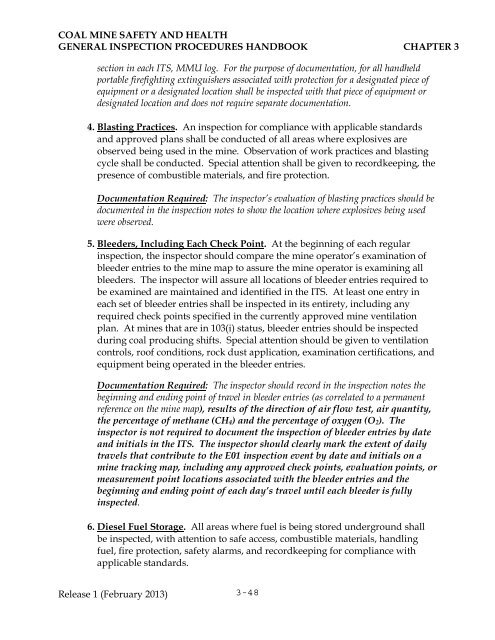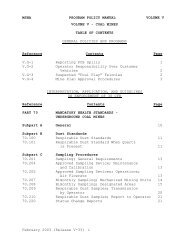MSHA HANDBOOK SERIES - PH13-V-1 - Mine Safety and Health ...
MSHA HANDBOOK SERIES - PH13-V-1 - Mine Safety and Health ...
MSHA HANDBOOK SERIES - PH13-V-1 - Mine Safety and Health ...
You also want an ePaper? Increase the reach of your titles
YUMPU automatically turns print PDFs into web optimized ePapers that Google loves.
COAL MINE SAFETY AND HEALTH<br />
GENERAL INSPECTION PROCEDURES <strong>HANDBOOK</strong> CHAPTER 3<br />
section in each ITS, MMU log. For the purpose of documentation, for all h<strong>and</strong>held<br />
portable firefighting extinguishers associated with protection for a designated piece of<br />
equipment or a designated location shall be inspected with that piece of equipment or<br />
designated location <strong>and</strong> does not require separate documentation.<br />
4. Blasting Practices. An inspection for compliance with applicable st<strong>and</strong>ards<br />
<strong>and</strong> approved plans shall be conducted of all areas where explosives are<br />
observed being used in the mine. Observation of work practices <strong>and</strong> blasting<br />
cycle shall be conducted. Special attention shall be given to recordkeeping, the<br />
presence of combustible materials, <strong>and</strong> fire protection.<br />
Documentation Required: The inspector’s evaluation of blasting practices should be<br />
documented in the inspection notes to show the location where explosives being used<br />
were observed.<br />
5. Bleeders, Including Each Check Point. At the beginning of each regular<br />
inspection, the inspector should compare the mine operator’s examination of<br />
bleeder entries to the mine map to assure the mine operator is examining all<br />
bleeders. The inspector will assure all locations of bleeder entries required to<br />
be examined are maintained <strong>and</strong> identified in the ITS. At least one entry in<br />
each set of bleeder entries shall be inspected in its entirety, including any<br />
required check points specified in the currently approved mine ventilation<br />
plan. At mines that are in 103(i) status, bleeder entries should be inspected<br />
during coal producing shifts. Special attention should be given to ventilation<br />
controls, roof conditions, rock dust application, examination certifications, <strong>and</strong><br />
equipment being operated in the bleeder entries.<br />
Documentation Required: The inspector should record in the inspection notes the<br />
beginning <strong>and</strong> ending point of travel in bleeder entries (as correlated to a permanent<br />
reference on the mine map), results of the direction of air flow test, air quantity,<br />
the percentage of methane (CH4) <strong>and</strong> the percentage of oxygen (O2). The<br />
inspector is not required to document the inspection of bleeder entries by date<br />
<strong>and</strong> initials in the ITS. The inspector should clearly mark the extent of daily<br />
travels that contribute to the E01 inspection event by date <strong>and</strong> initials on a<br />
mine tracking map, including any approved check points, evaluation points, or<br />
measurement point locations associated with the bleeder entries <strong>and</strong> the<br />
beginning <strong>and</strong> ending point of each day’s travel until each bleeder is fully<br />
inspected.<br />
6. Diesel Fuel Storage. All areas where fuel is being stored underground shall<br />
be inspected, with attention to safe access, combustible materials, h<strong>and</strong>ling<br />
fuel, fire protection, safety alarms, <strong>and</strong> recordkeeping for compliance with<br />
applicable st<strong>and</strong>ards.<br />
Release 1 (February 2013) 3-48
















